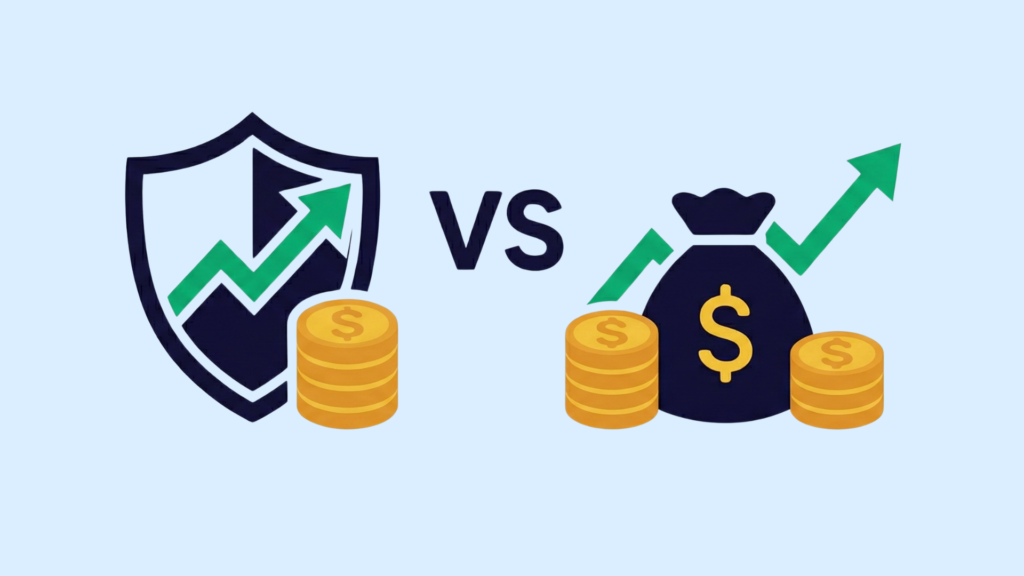When investors look for stability along with the potential for steady growth, large-cap mutual funds often come up as the preferred choice. These funds invest in companies that rank among the top 100 by market capitalization—well-established businesses that dominate their sectors and have a proven track record of performance.
Large-cap funds are considered less volatile compared to mid and small-cap funds, making them suitable for conservative as well as first-time investors. They not only provide exposure to industry leaders but also add balance to a diversified portfolio.
In this article, we’ll explain what large-cap funds are, why they matter, their benefits and risks, and how you can identify the best large-cap mutual funds in India.
Understanding Large Cap Funds
When investors ask, what is a large-cap fund, the answer lies in the companies it invests in. Large-cap funds are mutual funds that majorly invest in large-sized companies, typically ranked among the top 100 by market capitalisation in India. These are established businesses with a proven track record, strong financials, and a stable market presence.
By SEBI’s definition, large-cap companies are those ranked 1st to 100th in terms of complete market capitalization. Mutual funds categorised as large-cap schemes must allocate at least 80% of their assets into equity and equity-related instruments of these companies.
In short, large-cap funds are designed for investors seeking steady growth with relatively lower risk compared to mid and small-cap funds.
Features of Large-Cap Mutual Funds
If you’re wondering what large-cap mutual funds are, here are some of their defining features that make them popular among investors:
- Stability and Reliability: Large-cap companies are leaders in their sectors, with strong balance sheets and established operations. This makes large-cap funds less volatile compared to mid and small-cap funds.
- Diversification Benefits: A typical large-cap fund invests across multiple sectors like banking, IT, FMCG, and energy, providing a diversified portfolio that balances growth with stability.
- Lower Risk Compared to Smaller Caps: While not risk-free, large-cap funds tend to weather market downturns better than small-cap funds, making them suitable for conservative to moderate investors.
- Suitable for Long-Term Wealth Creation: The best large-cap mutual funds in India are often recommended for long-term goals such as retirement planning, children’s education, or wealth building due to their consistency.
Benefits of Investing in Large-Cap Funds
Investing in large-cap funds offers several benefits to investors looking for both growth and stability. These include:
- Steady Returns and Capital Preservation: Large-cap companies are market leaders with strong fundamentals. As a result, large-cap funds generally provide more consistent returns, even during volatile market phases, while protecting invested capital better than mid or small-cap funds.
- Long-Term Wealth Creation: While returns may not be as aggressive as small-cap funds, the best large-cap mutual funds can deliver steady compounding over 5–10 years, making them best for long-term financial goals like retirement or children’s education.
- Professional Fund Management: Large-cap funds are managed by experienced fund managers who actively monitor company performance and economic trends, ensuring that your money is allocated efficiently across stable, high-quality businesses.
How to Choose the Best Large-Cap Fund in India
With dozens of schemes available, finding the best large-cap mutual funds in India requires careful evaluation. Here are key factors to consider:
- Past Performance: Review a fund’s track record over 3-year and 5-year horizons. Consistent performance across different market cycles is a good sign of reliability. Look for the best-performing large-cap mutual funds that have outpaced or matched their benchmarks.
- Fund Manager Expertise: A fund manager’s experience and track record in handling large-cap portfolios can make a big difference. Check their past performance across different schemes they manage.
- Expense Ratio: The lower the expense ratio, the more of your returns you retain. When comparing options, look for the best large-cap fund that balances performance with low management costs.
- Assets Under Management (AUM): A larger AUM indicates investor trust, but an extremely large AUM may dilute returns. Ideally, pick funds with a healthy AUM that shows stability without being oversized.
Top Large Cap Mutual Funds to Consider
Below are some of the top large-cap mutual funds in India as of September 2025.
| Fund Name | AUM (₹ Cr.) | Expense Ratio | 5Y CAGR | Since Inception (Annualised) | Key Allocation |
| Nippon India Large Cap Fund | 45,012.18 | 0.69% | 26.6% | 16.54% | 82.48% Large Cap, 18.04% Private Banks |
| ICICI Prudential Large Cap Fund | 71,839.85 | 0.86% | 23.18% | 15.92% | 83.52% Large Cap, 21.85% Private Banks |
| HDFC Large Cap Fund | 37,659.18 | 0.99% | 22.89% | 14.20% | 87.53% Large Cap, 27.33% Private Banks |
| Franklin India Large Cap Fund | 7,689.74 | 1.08% | 22.01% | 13.11% | 90.76% Large Cap, 23.27% Private Banks |
| Tata Large Cap Fund | 2,615.27 | 0.99% | 21.34% | 14.07% | 82.23% Large Cap, 24.36% Private Banks |
Risks Associated with Large Cap Mutual Funds
While large-cap mutual funds are considered relatively safer than mid and small-cap categories, they are not risk-free.
- Market Volatility Impact: Large-cap funds invest in leading companies, but they still reflect the overall stock market’s ups and downs. In the short term, even the best large-cap mutual funds can see value erosion during economic downturns or market corrections.
- Limited Growth Potential Compared to Mid/Small-Cap Funds: Since large-cap companies are already established market leaders, their growth rates are generally slower. This means the best-performing large-cap mutual funds may not deliver the explosive returns seen in mid-cap or small-cap funds during bull runs.
Investment Strategy for Large Cap Funds
To get the most out of large-cap funds, investors should follow a disciplined strategy that involves:
- Assessing Ideal Investment Horizon: Large-cap mutual funds work best when held for the long term (5–7 years or more). Their stability and steady compounding make them suitable for wealth creation over extended periods.
- Allocating in a Diversified Portfolio: Large-cap funds should form the foundation of an investor’s portfolio, especially for those with moderate risk tolerance. They can be paired with mid-cap, small-cap, or debt funds to balance risk and growth.
- Large-cap funds should form the core of a diversified investment portfolio, especially for investors with a moderate risk tolerance.
- Our Daily SIP at ₹11 a day option can be the foundation of your portfolio, allowing you to build a consistent, long-term strategy that grows over time without the need for large upfront investments.
Investors seeking steady growth with lower volatility should prioritise large-cap funds as their core allocation.
Did you know?
US ETFs (Exchange Traded Funds) offer a great opportunity for investors looking to diversify their portfolio with international exposure. With Appreciate, you can now access these ETFs easily, benefiting from the growth of US-based companies. Investing in US ETFs can be a strategic way to tap into global markets, adding stability and potential growth to your investment strategy.
FAQs
What is the difference between large-cap and mid/small-cap mutual funds?
Large-cap funds invest in companies ranked in the top 100 by market capitalisation, offering stability and relatively lower risk. Mid and small-cap funds target smaller companies that have higher growth potential but also come with higher volatility and risk.
Are large-cap funds suitable for beginners?
Yes, large-cap mutual funds are often considered the safest entry point for new investors. Their stability and lower risk compared to mid/small-cap funds make them a good starting option for building wealth gradually.
How much should I invest in large-cap mutual funds?
There’s no fixed rule, but financial advisors generally recommend allocating 40–60% of your equity portfolio to large-cap funds, especially for conservative or first-time investors. The exact amount depends on your financial goals and risk appetite.
What are the tax implications of investing in large-cap funds?
Like other equity mutual funds, gains from large-cap funds are taxed based on the holding period:
- Short-Term Capital Gains (STCG): If held for less than 1 year, gains are taxed at 15%.
- Long-Term Capital Gains (LTCG): If held for more than 1 year, gains above ₹1 lakh are taxed at 10% without indexation.
How to identify the best large-cap mutual fund in India?
Look for consistency in performance against the benchmark (Nifty 100, Sensex, etc.), experienced fund management, lower expense ratio, strong AUM, and risk-adjusted return metrics like Sharpe Ratio. Comparing the best-performing large-cap mutual funds in India on platforms like Value Research, Moneycontrol, or AMFI can also help.
Disclaimer
The information provided in this article is for educational and informational purposes only. It should not be considered as financial or investment advice. Investing in stocks involves risk, and it is important to conduct your research and consult with a qualified financial advisor before making any investment decisions. The author and publisher are not responsible for any financial losses or gains that may result from the use of this information.























